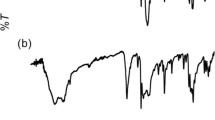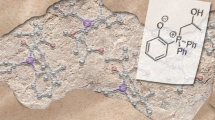Abstract
The reaction of phosphine ligand endo,endo-2,3-bis(diphenylphosphinomethyl)-5-norbornene (dpmn) with PtCl2(cod) and PtMe2(cod) yields PtCl2(dpmn) (2) and PtMe2(dpmn) (4), respectively. Treatment of 2 with excess MeLi or MeMgCl also furnishes 4 in good yield. Both new platinum compounds have been isolated and characterized by NMR spectroscopy (1H and 31P), elemental analyses, and X-ray crystallography. 2 Crystallizes, as the CH2Cl2 solvate, in the orthorhombic space group Pnma, a = 18.062(3) Å, b = 16.602(3) Å, c = 11.088(2) Å, V = 3,324.7(9) Å3, Z = 4, D cacl = 1.681 mg/m3; R = 0.0432, R w = 0.0759 for 3,755 observed reflections with I > 2σ(I). 4 Crystallizes, as the CH2Cl2 solvate, in the orthorhombic space group Pnma, a = 17.969(3) Å, b = 16.689(3) Å, c = 11.237(2) Å, V = 3,370(1) Å3, Z = 4, D cacl = 1.610 mg/m3; R = 0.0268, R w = 0.0665 for 4,098 observed reflections with I > 2σ(I). The solid-state structures of 2 and 4 confirm the coordination of the platinum(II) center by the seven-membered chelating dpmn ligand; 2 and 4 represent the first structurally characterized examples of organometallic compounds based on the endo,endo-2,3-bis(diphenylphosphinomethyl)-5-norbornene ligand.
Graphical Abstract
The new platinum(II) compounds PtCl2(dpmn) (2) and PtMe2(dpmn) (4) have been synthesized, and their structures established by NMR spectroscopy (1H and 31P) and X-ray crystallography. Compounds 2 and 4 are the first structurally characterized examples of organometallic compounds containing the endo,endo-2,3-bis(diphenylphosphinomethyl)-5-norbornene (dpmn) ligand.



Similar content being viewed by others
Notes
The 3JP–H coupling constant reported in references [34, 42] was extracted by treating the methyl resonance as though it behaved as a conventional triplet. We would point out that the introduction of line broadening in excess of 2 Hz in the spectral simulations also promotes the collapse of the intense inner lines of the multiplet, as would the presence of any paramagnetic impurity, leading to the production of a simple triplet resonance for the methyl groups.
References
Rothenberg G (2008) Catalysis: concepts and green applications. Wiley-VCH, New York
Casey CP, Petrovich LM (1995) J Am Chem Soc 117:6007
Dierkes P, van Leeuwen PWNM (1999) J Chem Soc, Dalton Trans 1519
Freixa Z, Leeuwen PWNM (2003) J Chem Soc, Dalton Trans 1890
Yang K, Smith JM, Bott SG, Richmond MG (1993) Organometallics 12:4779
Shen H, Bott SG, Richmond MG (1995) Organometallics 14:4625
Bott SG, Yang K, Wang JC, Richmond MG (2000) Inorg Chem 39:6051
Bott SG, Shen H, Senter RA, Richmond MG (2003) Organometallics 22:1953
Watson WH, Wu G, Richmond MG (2006) Organometallics 25:930
Watson WH, Bodige SG, Ejsmont K, Liu J, Richmond MG (2006) J Organomet Chem 691:3609
Watson WH, Kandala S, Richmond MG (2007) J Organomet Chem 692:968
Poola B, Wang X, Richmond MG (2007) J Chem Crystallogr 37:641
Nesterov V, Poola B, Wang X, Richmond MG (2007) J Organomet Chem 692:1806
Watson WH, Wu G, Richmond MG (2008) J Organomet Chem 693:1439
Bott SG, Shen H, Huang SH, Richmond MG (2008) J Organomet Chem 693:2327
Unpublished results: Yang L, Huang SH, Wang X, Richmond MG
Knight JG, Doherty S, Harriman A, Robins EG, Betham M, Eastham GR, Tooze RP, Elsegood MRJ, Champkin P, Clegg W (2000) Organometallic 19:4957
Brunner H, Kramler K (1991) Synthesis 12:1121
Brunner H, Prester F (1991) J Organomet Chem 414:401
Kreuzfeld HJ, Doebler C, Abicht HP (1987) J Organomet Chem 336:287
Doebler C, Kreuzfeld HJ (1981) J Prak Chem 323:667
Kreuzfeld HJ, Doebler C (1981) React Kinet Catal Lett 16:229
Drew D, Doyle JR (1990) Inorg Synth 28:346
Clark HC, Manzer LE (1973) J Organomet Chem 59:411
Shriver DF (1969) The Manipulation of air-sensitive compounds. McGraw-Hill, New York
Saint Version 6.02, Bruker advanced analytical X-ray systems, Inc. Copyright 1997–1999
SHELXTL Version 5.1, Bruker advanced analytical X-ray systems, Inc. Copyright 1998
PLATON—A multipurpose crystallographic tool (2001) Utrecht University, Utrecht, The Netherlands, Spek, AL
Nagao Y, Inoue T, Fujita E, Terada S, Shiro M (1984) Tetrahedron 40:1215
Brown DH, Cross RJ, Keat R (1980) J Chem Soc, Dalton Trans 871
Duncan M, Gallagher MJ (1981) Org Mag Reson 15:37
Quin LD, Williams AJ (2004) Practical interpretation of P-31 NMR spectra and computer assisted structure verification. Advanced Chemistry Development, Toronto
King RB, Kapoor PN (1971) J Am Chem Soc 93:4158
Appleton TG, Bennett MA, Tomkins IB (1976) J Chem Soc Dalton Trans 439
Garrou PE (1981) Chem Rev 81:229
Oberhauser W, Bachmann C, Brüggeller P (1995) Inorg Chim Acta 238:35
Oberhauser W, Bachmann C, Stampfl T, Haid R, Langes C, Rieder P, Brüggeller P (1998) Inorg Chim Acta 274:143
Engelhardt LM, Patrick JM, Raston CL, Twiss P, White AH (1984) Aust J Chem 37:2193
Johansson MH, Malmstrom T, Wendt OF (2001) Inorg Chim Acta 316:149
Powell J, Horvath MJ, Lough A (1996) J Chem Soc Dalton Trans 1679
Bovio B, Bonati F, Banditelli G (1985) Gazz Chim Ital 115:613
Hooton KA (1970) J Chem Soc (A) 1896
Cheney AJ, Mann BE, Shaw BL (1971) Chem Comm 431
Appleton TG, Clark HC, Manzer LE (1973) Coord Chem Rev 10:335
Mather GG, Pidcock A, Rapsey GJN (1973) J Chem Soc Dalton Trans 2095
Haar CM, Nolan SP, Marshall WJ, Moloy KG, Prock A, Giering WP (1999) Organometallics 18:474
Thomas JC, Peters JC (2003) J Am Chem Soc 125:8870
Smith DC Jr, Haar CM, Stevens ED, Nolan SP, Marshall WJ, Moloy KG (2000) Organometallics 19:1427
Arthur KL, Wang QL, Bregel DM, Smythe NA, O’Neill BA, Goldberg KI, Moloy KG (2005) Organometallics 24:4624
Acknowledgments
The NOESY NMR experiments were conducted at the UNT NMR facility with the expert help of Dr. Hongjun Pan, and financial support from the Robert A. Welch Foundation (Grants P-0074-WHW and B-1093-MGR) is much appreciated.
Author information
Authors and Affiliations
Corresponding authors
Rights and permissions
About this article
Cite this article
Watson, W.H., Huang, SH., Yang, L. et al. Ligand Substitution Chemistry of the Diphosphine Ligand endo,endo-2,3-Bis(diphenylphosphinomethyl)-5-norbornene (dpmn): Syntheses and X-ray Diffraction Structures of PtCl2(dmn) and PtMe2(dpmn) . J Chem Crystallogr 39, 740–746 (2009). https://doi.org/10.1007/s10870-009-9553-9
Received:
Accepted:
Published:
Issue Date:
DOI: https://doi.org/10.1007/s10870-009-9553-9




